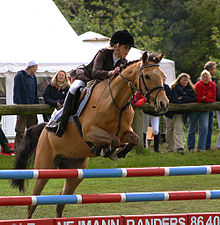This article needs additional citations for verification .(July 2011) |

English riding is a form of horse riding seen throughout the world. There are many variations, but all feature a flat English saddle without the deep seat, high cantle, or saddle horn found on a Western saddle, nor the knee pads seen on an Australian stock saddle. Saddles within the various English disciplines are all designed to allow the horse the freedom to move in the optimal manner for a given task, ranging from classical dressage to horse racing. English bridles also vary in style based on discipline, but most feature some type of cavesson noseband as well as closed reins, buckled together at the ends, that prevents them from dropping on the ground if a rider becomes unseated. Clothing for riders in competition is usually based on traditional needs from which a specific style of riding developed, but most standards require, as a minimum, boots; breeches or jodhpurs; a shirt with some form of tie or stock; a hat, cap, or equestrian helmet; and a jacket.
Contents
English riding is an equestrian discipline with many different styles; however, at the most basic level, most versions require riders to use both hands on the reins, rather than just one hand, as is often seen in western riding. Riders generally "post" or "rise" to the trot (rising and sitting in rhythm with each stride). The "posting trot" is used most often in a working or extended trot, although there are also times when English riders may sit the trot; the "sitting trot" is most often used to ride collected forms of the trot seen in dressage, show hack and hunt seat equitation competition.

